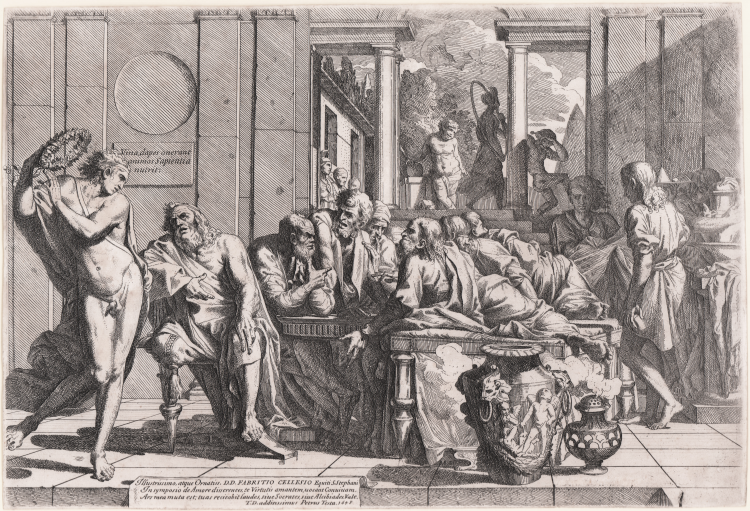




| Reference: | S32426 |
| Author | Pietro TESTA detto "Il Lucchesino" |
| Year: | 1648 |
| Measures: | 383 x 260 mm |



| Reference: | S32426 |
| Author | Pietro TESTA detto "Il Lucchesino" |
| Year: | 1648 |
| Measures: | 383 x 260 mm |
Etching, 1648, dated and signed in panel lower left.
Good impression, printed on a sheet of contemporary laid paper, trimmed close to the platemark, some foxing on the back, very smalls wormholes, otherwise in good condition.
Example of II state, of four, with four lines of dedication by Testa to Fabrizio Cellesio.
The Symposium of Plato, with Alcibiades interrupting the discourse of Socrates and the philosophers in a portico with a metal vase and an incense burner.
The preparatory drawing is preserved at Louvre (inv. 1902), the copperplate at Calcografia Nazionale (inv. 975/2).
Pietro Testa was called Lucchesino for he was born in Lucca. There are but a few news about his apprenticeship in his hometown; for sure, he went to Rome in 1629 to study in the school of Domenichino first and then, towards the end of the year, he moved to the studio of his real master, Pietro da Cortona. His introvert temper caused him a lot of troubles; Cortona, in fact, was obliged to send him away due to his hostile and disdainful behaviour.
Testa went then to the house of his first patron, the famous collector Cassiano del Pozzo, and for him he realized his drawings from antiques. Maybe it was in this house that he met Nicolas Poussin who deeply influenced his art both in the neo-Venetian phase and the intellectual classicist one, from 1635.
His engravings though, about 40 pieces, have been considered, starting from Sandrart and Bladinucci, the most important graphic works of the Italian XVII century.
|
Bartsch,XX.220.18; Bellini, 38; Cropper 1988 114.II
|
Pietro TESTA detto "Il Lucchesino" (Lucca 1611 - Roma 1650)
|
Pietro Testa was called Lucchesino for he was born in Lucca. There are but a few news about his apprenticeship in his hometown; for sure, he went to Rome in 1629 to study in the school of Domenichino first and then, towards the end of the year, he moved to the studio of his real master, Pietro da Cortona. His introvert temper caused him a lot of troubles; Cortona, in fact, was obliged to send him away due to his hostile and disdainful behaviour.
Testa went then to the house of his first patron, the famous collector Cassiano del Pozzo, and for him he realized his drawings from antiques. Maybe it was in this house that he met Nicolas Poussin who deeply influenced his art both in the neo-Venetian phase and the intellectual classicist one, from 1635.
His engravings though, about 40 pieces, have been considered, starting from Sandrart and Bladinucci, the most important graphic works of the Italian XVII century.
His last production is characterized by classical and complex symbols and by the myths of Stoic philosophy, which he had followed all along his life. This pessimistic idea of life and the universal drama that humanity was living can be considered the main causes of his melacholy and sadness which led to commit suicide in 1650, when Testa threw himself down to the Tiber, near Lungara
|
|
Bartsch,XX.220.18; Bellini, 38; Cropper 1988 114.II
|
Pietro TESTA detto "Il Lucchesino" (Lucca 1611 - Roma 1650)
|
Pietro Testa was called Lucchesino for he was born in Lucca. There are but a few news about his apprenticeship in his hometown; for sure, he went to Rome in 1629 to study in the school of Domenichino first and then, towards the end of the year, he moved to the studio of his real master, Pietro da Cortona. His introvert temper caused him a lot of troubles; Cortona, in fact, was obliged to send him away due to his hostile and disdainful behaviour.
Testa went then to the house of his first patron, the famous collector Cassiano del Pozzo, and for him he realized his drawings from antiques. Maybe it was in this house that he met Nicolas Poussin who deeply influenced his art both in the neo-Venetian phase and the intellectual classicist one, from 1635.
His engravings though, about 40 pieces, have been considered, starting from Sandrart and Bladinucci, the most important graphic works of the Italian XVII century.
His last production is characterized by classical and complex symbols and by the myths of Stoic philosophy, which he had followed all along his life. This pessimistic idea of life and the universal drama that humanity was living can be considered the main causes of his melacholy and sadness which led to commit suicide in 1650, when Testa threw himself down to the Tiber, near Lungara
|